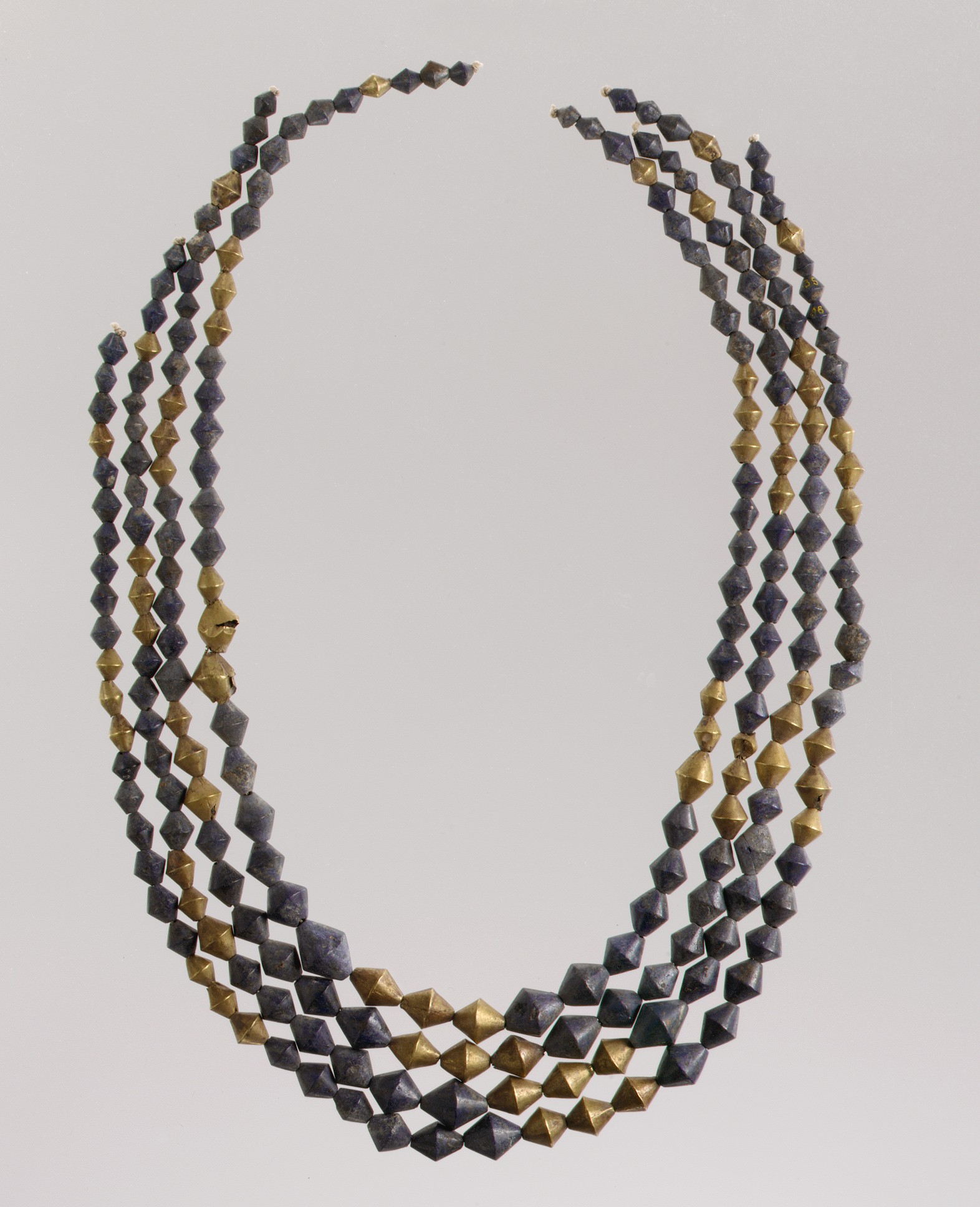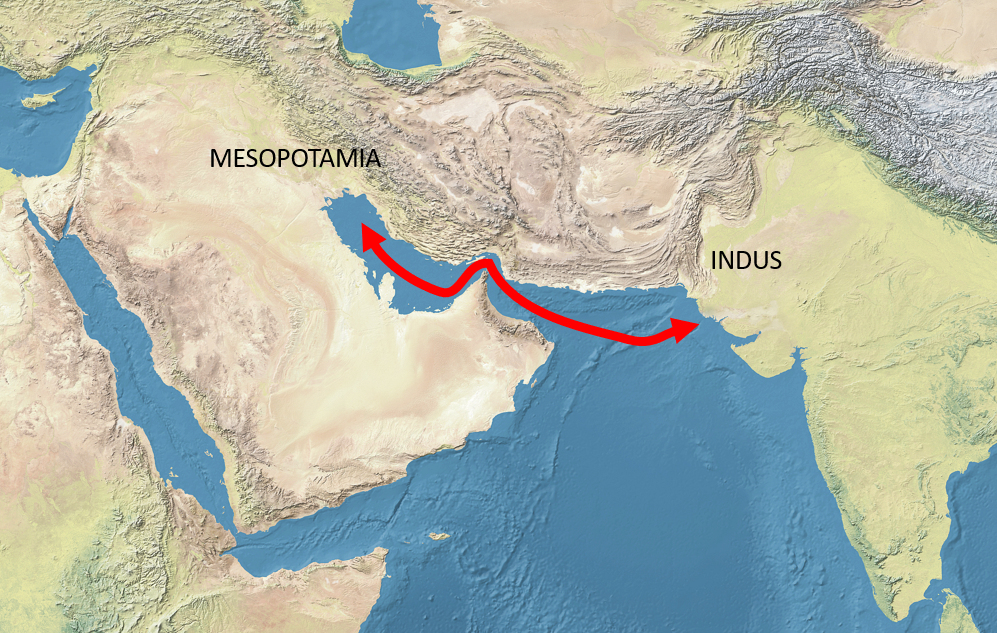The Mesopotamian lapis lazuli trade route and other trade networks: The foundations of civilization
Trade has always been a cornerstone of human civilization, facilitating the exchange of goods, ideas, and cultural practices. In ancient Mesopotamia, one of the earliest cradles of urbanization, trade played a crucial role in the emergence and sustenance of city-states. Among the many trade routes that connected Mesopotamia to surrounding regions, the lapis lazuli route to Central Asia stands out as one of the most significant, predating the Silk Road by millennia.

Crystals of lazurite (the main mineral in lapis lazuli) from the Sar-i Sang Mining District in Afghanistan. Source: Wikimedia Commonsꜛ (license: CC BY-SA 4.0)
The Mesopotamian lapis lazuli trade route
Lapis lazuli, a vibrant blue semi-precious stone, held immense cultural and economic value in ancient Mesopotamia. Prized for its striking color and rarity, it was used extensively in religious rituals, jewelry, and artistic works. Lapis lazuli was associated with divinity and power, making it a key material in the crafting of royal and temple artifacts.

Lapis lazuli in its natural state, with pyrite inclusions (specimen from Afghanistan). Source: Wikimedia Commonsꜛ (license: CC BY-SA 2.5)
The primary source of lapis lazuli was the Badakhshan region in what is now northeastern Afghanistan. From these mines, the stone was transported along a complex trade route that spanned Central Asia and connected to Mesopotamian city-states such as Uruk, Ur, and Lagash. This route, often referred to as the “Lapis Lazuli Road”, is one of the earliest known examples of long-distance trade networks.
The lapis lazuli trade involved multiple intermediaries and spanned thousands of kilometers. Evidence suggests that traders transported the stone through regions such as the Iranian plateau, possibly passing through sites like Tepe Sialk and Susa, before reaching Mesopotamia. These intermediary locations not only facilitated the movement of goods but also served as cultural exchange hubs, fostering interactions between disparate regions.
Economic and cultural implications of the lapis lazuli trade
The trade in lapis lazuli had profound economic and cultural implications for Mesopotamian society. Economically, it underscored the interconnectedness of the ancient world, with Mesopotamian city-states relying on distant regions for critical resources. The procurement of lapis lazuli, along with other imported goods such as tin and copper, was essential for the production of high-value items that symbolized wealth and authority.

Ancient Egyptian cult image of Ptah, 945–600 BCE, lapis lazuli. Source: Wikimedia Commonsꜛ (license: CC BY-SA 1.0)
Culturally, lapis lazuli became a symbol of divine favor and cosmic order in Mesopotamian religion. Its use in temple offerings, cylinder seals, and ceremonial objects reflects its role in bridging the human and divine realms. Artifacts such as the Standard of Ur, which incorporates lapis lazuli, exemplify the stone’s significance in Mesopotamian art and iconography.
 The Standard of Ur (3rd millennium BCE) in the British Museum. Source: Wikimedia Commonsꜛ (license: CC BY-SA 2.0)
The Standard of Ur (3rd millennium BCE) in the British Museum. Source: Wikimedia Commonsꜛ (license: CC BY-SA 2.0)
The trade also facilitated technological and cultural diffusion. Mesopotamia’s interactions with Central Asia and intermediary regions contributed to the exchange of ideas, technologies, and artistic styles, shaping the evolution of Mesopotamian civilization.


Left: Greek or Roman ring stone; lapis lazuli. Source: Wikimedia Commonsꜛ (license: CC BY-SA 1.0) – Right: Sumerian necklace beads; 2600–2500 BCE; gold and lapis lazuli. Source: Wikimedia Commonsꜛ (license: CC BY-SA 1.0)
‚


Left: Sumerian bald clean-shaven male worshipper head, 2600–2500 BCE, gypsum, shell, lapis lazuli and bitumen, from Nippur (Iraq). Source: Wikimedia Commonsꜛ (license: CC BY-SA 2.0) – Right: Ancient Egyptian plaque with an Eye of Horus, 664–332 BCE, lapis lazuli. Source: Wikimedia Commonsꜛ (license: CC BY-SA 1.0)
Other significant trade routes in Mesopotamia
While the lapis lazuli trade route was one of the most remarkable, Mesopotamia was also connected to other important trade networks that enriched its economy and culture.
The Persian Gulf trade
The Persian Gulf trade route linked Mesopotamia to the Arabian Peninsula and the Indus Valley. Goods such as copper from Oman, pearls from the Gulf, and exotic items like carnelian beads from the Indus Valley reached Mesopotamia through this maritime network. Evidence of Mesopotamian seals and pottery in sites such as Dilmun (modern Bahrain) highlights the extent of these exchanges.

Trade routes between Mesopotamia and the Indus would have been significantly shorter due to lower sea levels in the 3rd millennium BCE. Source: Wikimedia Commonsꜛ (license: CC BY-SA 3.0)
The Anatolian trade
The Anatolian trade route connected Mesopotamia to Anatolia, a key source of tin and silver. Tin, essential for the production of bronze, was a critical resource for Mesopotamian metallurgy. Texts from the city of Kanesh (modern-day Kültepe) in Anatolia detail the extensive trade relations between Assyrian merchants and Anatolian city-states, showcasing the complexity of these interactions.
The Levantine trade
The Levantine trade route linked Mesopotamia to the Mediterranean coast, facilitating the exchange of timber, wine, and luxury goods. Cedar wood from Lebanon, highly prized in Mesopotamian construction and shipbuilding, was among the most significant imports from this region.
The role of trade in early Mesopotamian civilization
Trade was not merely an economic activity in Mesopotamia; it was a driving force behind the growth of cities and the centralization of political power. The accumulation of wealth through trade enabled the construction of monumental architecture, the establishment of bureaucratic systems, and the development of complex social hierarchies.
The growth of trade networks also necessitated advancements in technology and administration. Innovations such as writing, initially developed to record economic transactions, and standardized weights and measures reflect the central role of trade in shaping Mesopotamian society. The rise of powerful city-states like Uruk and Ur was closely tied to their ability to control trade routes and resources.
Decline and legacy
The prominence of Mesopotamian trade routes fluctuated over time, influenced by shifts in political power and environmental conditions. Despite these changes, the legacy of Mesopotamian trade endured, shaping the economic and cultural landscapes of the ancient Near East.
The lapis lazuli trade, in particular, highlights the interconnectedness of early civilizations and the human drive to obtain and trade valued resources. It stands as a testament to the ingenuity and resilience of ancient traders who navigated vast distances to link disparate regions, laying the groundwork for the complex trade networks that would follow, including the Silk Road.
Conclusion
The Mesopotamian lapis lazuli trade route to Central Asia and other trade networks played a foundational role in the emergence of civilization. These routes not only facilitated the exchange of goods but also fostered cultural and technological innovation, shaping the trajectory of Mesopotamian society and influencing neighboring regions. By examining these trade networks, we gain a deeper understanding of the interconnectedness and complexity of early human civilizations.
References and further reading
- Harriet E. W. Crawford, Sumer and the Sumerians, 2004, Cambridge University Press, ISBN: 9780521533386
- Potts, D. T., Mesopotamian Civilization: The Material Foundations, 1996, Cornell University Press, ISBN: 978-0801433399
- Henri Frankfort, The Birth of Civilization in the Near East, 2021, Alpha Editions, ISBN: 978-9355111531
- Lamberg-Karlovsky, C. C., & Sabloff, J. A., Ancient Civilizations: The Near East and Mesoamerica, 1995, Waveland Press, ISBN: 978-0881338348
- Guillermo Algaze, The Uruk World System: The Dynamics of Expansion of Early Mesopotamian Civilization, 1993, University of Chicago Press, ISBN: 9780226013781
- Wikipedia article on Lapis lazuliꜛ
- Wikipedia article on the modern Lapis Lazuli trade routeꜛ
- Wikipedia article on the Standard of Urꜛ

































comments